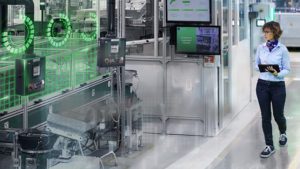Two major trends are accelerating the pace of modern industrial transformation: increased pressure to improve productivity and boost ROI and the relatively low cost of IT-driven data acquisition and analysis. A recent LNS Research report survey bears this out by indicating that 45% of industrial organizations surveyed are already engaged in industrial transformation, and another 23% of companies expect to launch programs within one year. The research goes on to identify the top 28% most active organizations as “Industrial Transformation Leaders” and indicates that these leaders are 53% more likely to focus on smart connected products as a channel for growing revenue and market share.
LNS Research identifies two “life lessons” gathered from the survey data. First, the primary focus of an Industrial Transformation program must be the pursuit of business benefit, not testing technology for insight. Second, broad focus and scope are critical for success.
Digitization business benefits multiply across industries
Leading industrial organizations are now pursuing digital transformation (which has come to mean the same as industrial transformation, since the core initiative surrounds the digitization of industrial processes) for five primary reasons:
- Correction of operational inefficiencies – Unlike the traditional rip and replace model where a newer, faster, cheaper industrial automation system supersedes an older one, the focus is now on how to extract higher efficiency values from existing installed equipment. The emphasis is on tackling short-term operational inefficiencies before completely rebuilding the process. Adding an IIoT-based system boosted by analytics and machine learning quickly increases the yield of each asset and improves the overall equipment efficiency. These basic operational efficiency initiatives produce impressive short-term returns. Consider the example of Casa Granado, a leading Brazilian cosmetics producer. They implemented an open EcoStruxure architecture that served as a base for integrating batch management and their manufacturing execution system (MES), along with some operations and maintenance tools. This quickly resulted in a 15% improvement in production yield.
- Creation of competitive advantage – New software tools that acquire and analyze connected device-generated data improve operational efficiency in areas such as asset performance, energy management, and smart machine performance. These improvements then open the door to new revenue streams and business opportunities, thereby enhancing competitive advantage. For example, China’s Jiangsu Jinwang Packaging Machinery Sci-Tech Co., Ltd, an agrochemical packaging smart machine builder, invested in an EcoStruxure-ready connected machine solution, edge control, and analytics to provide smart production and maintenance services for its customers. As a result, their machine service efficiency improved by 35% while maintenance costs were reduced by over 30%.
- Elimination of inefficient processes – Once obvious operational inefficiencies are addressed, digital transformation also can help tackle the more complex process inefficiencies. This is an area where collaboration with external experts provides valuable guidance. An example in the mining industry is that of a data consultant that helped support a copper mining company through the use of remote tools that replicate business processes and plant behaviors. Expert consultants monitor operations remotely and in real-time, filling in knowledge gaps where expertise is lacking so that process efficiencies can improve. In this remote “cockpit” environment (a command center where a consolidated view of key dashboards is monitored), the consultants utilize digitization tools to help to define a more efficient process. Stakeholders project economic benefits totaling $12 million US per year without committing any additional capital expenditure.
- Establishment of a stable IT/OT architecture base – The integration of industrial and engineering software allows the emergence of a closed loop digital view that enables increased efficiencies throughout an entire product lifecycle. Working with Schneider Electric partner AVEVA, ADNOC, the national oil company of Abu Dhabi, invested in its Panorama Initiative to connect 100,000 data points from across 16 of its operating companies into a single view. This level of interconnectivity provides an automated method of managing the business by analyzing both current and near-future operational requirements and comparing plans to actual performance.
- Creation of new customer value and new business models – Connected products across industries not only bring new value to end customers (like faster deliveries and higher quality products at less cost), but also prove valuable at introducing new business models. Many customers, for example, are not interested in buying machines. They are interested in the output the machines produce. Therefore, new business models, like performance contracting, are being introduced where customers only pay for output (like the number of cubic meters of compressed air utilized over a fixed period of time) or the amount of energy they save as the result of a high efficiency variable speed drive. Digitization tools can now precisely measure these outputs so that both buyers and sellers can trust the contracting arrangement.
Across boardrooms, executives are now involving technology vendors in business discussions. Once the business problem is understood, technologies are introduced to extract data, treat data, and translate data into dashboards and advisors. The current wave of industrial transformation is about connecting and enhancing existing systems to achieve a business benefit. For this reason, connectivity platforms such as EcoStruxure provide an open framework for enabling new ways to solve business-driven challenges across industries.
Schneider Electric has sponsored a series of research by LNS Research aimed at helping you understand and implement digital transformation as a foundation for the ongoing success of your industrial enterprise. You can download a detailed eBook here.



